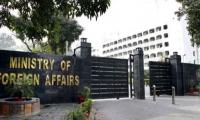Pakistan has pursued for over two decades have been delayed due to reasons beyond our control. The 750 MMCFD Iran-Pakistan (IP) gas pipeline has been delayed due to international sanctions; although there is now hope for removal of the sanctions and we will be going ahead with the construction of the IP pipeline, the first gas from the IP pipeline is at least 30 months in the future. The 1,325 MMCFD Turkmenistan-Afghanistan-Pakistan-India (TAPI) gas pipeline has been delayed due to the security situation in Afghanistan and structural issues with the project transaction; the first gas flow from the TAPI pipeline will take more than 48 months.
Fact 5 - LNG import remains the only solution to Pakistan’s gas and energy needs in the near future; the last 3 governments following an integrated approach, where the LNG regasification terminal developer was also the LNG supplier, failed in 5 separate attempts in 10 years to import LNG into Pakistan.
Fact 6 - The PML-N government using an unbundled approach, where the LNG regasification terminal was separated from LNG procurement, has succeeded in providing Pakistan with its first imported gases through LNG within the first 20 months of its tenure.
Fact 7 - Pakistan’s private sector has built the world’s fastest LNG regasification terminal in a period of less than 11 months; the contract was signed after a completely transparent PPRA-compliant bid process on April 30, 2014, and the first LNG based gas flowed into the system on March 26, 2015.
Fact 8 - The Fast Track LNG regasification terminal at Port Qasim was built in record time by Engro Elengy Terminals Limited (EETL), a 100% Pakistani company, without any public funds and without a sovereign guarantee on a tolling fee based BOOT model.
SSGC has committed to regasification of 400 MMCFD or 3 Million Tonnes per Annum (MTPA) of LNG through this terminal; the contracted LNG regasification tolling fee of $0.66/MMBTU is one of the lowest in the world, especially forFloating Regasification and Storage Unit (FSRU) based terminals.
Fact 9 - The negotiations under a PPRA-compliant government-to-government process for a long-term LNG supply contract between Pakistan State Oil (PSO) and Qatar Gas are in the final stages. Despite unsubstantiated and biased speculation to the contrary, the LNG price and several other terms affecting the LNG price are still under negotiation with Qatar Gas. The terms and flexibility in long-term LNG contracts are critical and PSO is committed to providing Pakistan with the best LNG contract price in Asia. The details of the LNG contract, once it is signed, will be made available on public forums as required under PPRA rules.
Fact 10 - There is a fundamental difference between the Oil market and the LNG market — Oil is produced first and then sold; LNG is sold first and then produced. The expected LNG contract with Qatar is for a volume of 1.5 MTPA, or half of the current LNG regasification terminal’s committed capacity. The balance 1.5 MTPA is being sourced through other term contracts or spot procurement. Pakistan is expected to be a 12 MTPA LNG market within 5 years; the current LNG contract is less than 15% of this amount. Globally, over 90% of LNG procurement is done through negotiated term contracts as there is no reliable spot market for LNG.
Fact 11 - Unlike oil, there is no international benchmark for LNG; although the US-based Henry Hub gas price may emerge as a LNG benchmark in the future. Most of the LNG contracts in the world today are priced at a direct linkage to oil; meaning that the per Million BTU (MMBTU) LNG price is a direct percentage of an oil benchmark. As an example, the LNG price at 15% of a Brent index of $60 would be $9 per MMBTU plus a $ Constant for shipping charges and losses.
Fact 12 - LNG prices are affected by supply and demand factors as any other commodity, but generally vary geographically and are based on the alternate fuel in a particular region. For example, in Asia LNG replaces fuel oil and is priced close to fuel oil prices; in Europe it competes with Russian or Norwegian pipeline gas and is priced accordingly; while in the US the competitive fuel is low price domestic shale-based gas making LNG imports impossible.
Fact 13 - LNG price can be linked to any benchmark; however, it would be a very risky gamble to link Pakistan’s LNG imports to any benchmark except oil as we are replacing fuel oil usage in the country. A few months back it was very fashionable to talk about Henry Hub based LNG; today when the Henry Hub has diverged from global oil prices, the talk has fallen silent. We cannot afford to gamble on our energy future by linking our LNG procurement to temporary fads.
Fact 14 - The current 400 MMCFD of Regasified LNG (RLNG) will be provided to the power sector; in this context, LNG with a notional Brent linkage of 14.5% is 10% cheaper than High Sulphur Furnace Oil (HSFO), 20% cheaper than Low Sulphur Furnace Oil (LSFO), and half the price of diesel. In addition, as a fuel for power generation, LNG as compared to liquid fuels provides substantially greater efficiency, lower maintenance costs, no storage costs, ease of transportation, and no pilferage or adulteration issues.
Fact 15 - The price of LNG has been the subject of much irrational and illogical comment, probably at the behest of certain vested interests. The cost of RLNG to the consumer has several elements including the landed cost of LNG, marketing company margin, port charges, regasification charges, and SSGC and SNGPL system usage charges, transmission and distribution losses. Energy cost calculations clearly proves that RLNG is cheaper than all other imported fuels for power generation in Pakistan. On April 27, 2015, the delivered price for fuel to power plants in Northern Pakistan on equivalent basis was $11.5/MMBTU for LNG, $12.6/MMBTU for HSFO, $13.8/MMBTU for LSFO, and $22.8/MMBTU for diesel.
Fact 16 - The 400 MMCFD of RLNG from the EETL Terminal will be provided to Nine (9) gas-based Independent Power Plants (IPP) - KAPCO, Fauji Kabirwala, Rouche, Halmore, Orient, Saif Energy, Sapphire, Altern Energy, and Davis Energen - for replacement of diesel or LSFO consumption. This RLNG will allow these power plants to generate an additional 9 billion KWh per annum, equivalent to an additional 10% of total current annual power generation, without investment in any new generation capacity.
Fact 17 - The 3 MTPA of LNG used to generate 400 MMCFD of RLNG will cost about $1.5 billion per annum at today’s Brent linkage; this RLNG will displace over $2.5 billion of Diesel and LSFO usage resulting in sustained annual savings of $1 billion. These are large savings by any standards.
Fact 18 - Natural gas is the most efficient fossil fuel for power generation; highest efficiency oil-fired power generation is about 46% efficient, while gas-fired power generation efficiency today exceeds 61%. The government is in the process of setting up 3600MW of RLNG-based power generation capacity which will generate 30 billion KWh every year, or equal to 35% of total current annual power generation. If this high efficiency RLNG-based power generation is used to replace current low efficiency oil-based power generation, the savings will exceed $2 billion per year.
Fact 19 - The first LNG cargo, which unfortunately has been the target of much speculative comment, was carried on the FSRU on its maiden voyage to Pakistan; it was also used as the commissioning cargo for the LNG regasification terminal. This cargo with a value of over $30 Million was procured by the private sector for use in fertilizer production, and is a landmark in the use of RLNG in the private sector. This underscores the importance and cost-effectiveness of RLNG as fertilizer feedstock and in other industrial uses. This procurement by the private sector has saved the public sector over $5 million in shipping and terminal commissioning costs, and ensured the ahead of schedule operation of Pakistan’s first LNG regasification terminal.
Fact 20 - RLNG for power generation has a substantially lower environmental impact than all other fossil fuel based plants and it will greatly reduce the carbon footprint for Pakistan. This will also help mitigate the expected increase in carbon emissions from domestic and imported coal power plants that Pakistan is in the process of constructing to lower the cost of its power generation mix.
These facts are based on an in-depth analysis of Pakistan’s energy issues and the use of LNG as a viable solution for our energy challenges. The bottom line is simple - LNG is the only cost-effective solution for Pakistan’s energy problems in the short to medium term perspective.The writer can be reached at shahid@airblue.com or by text at 0300-828 2942.







